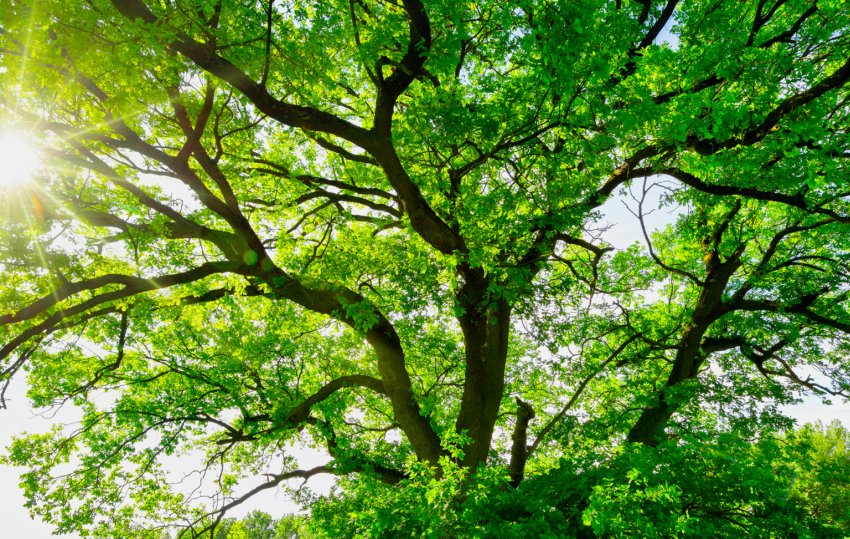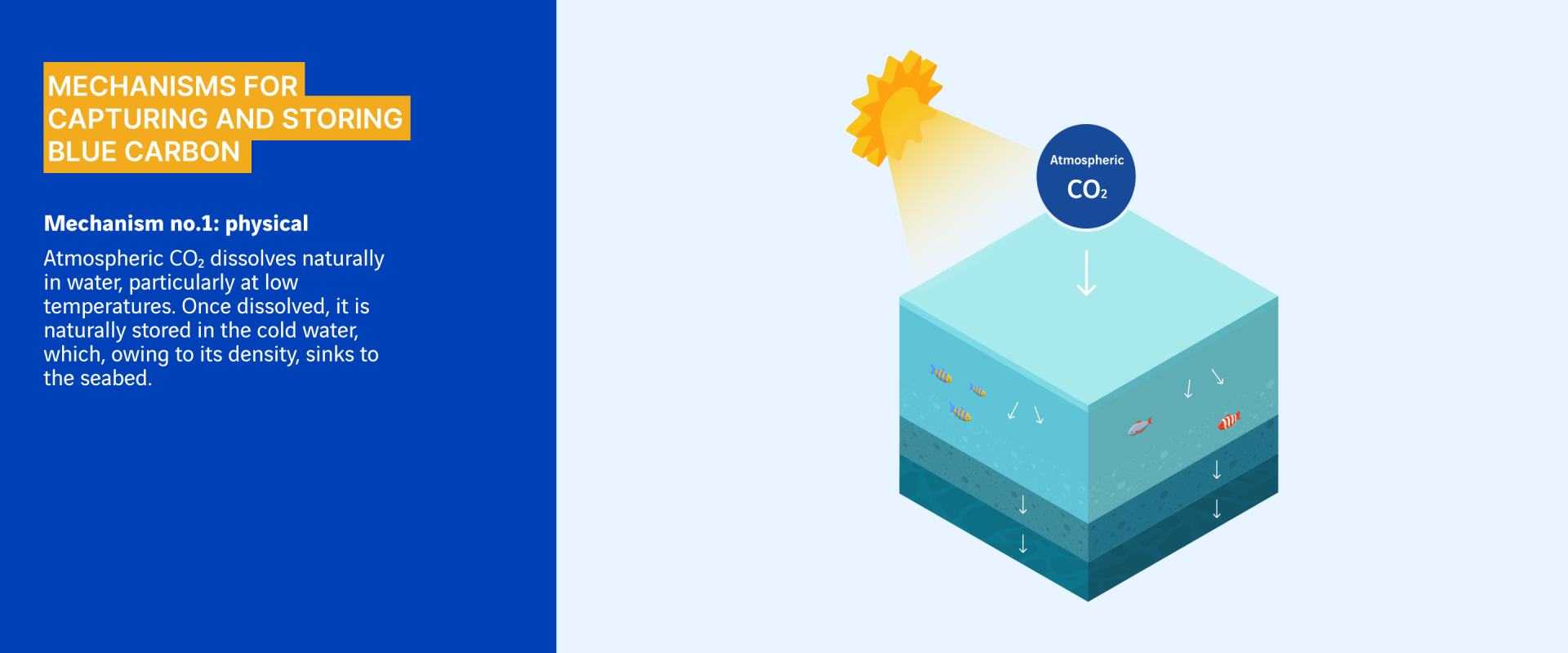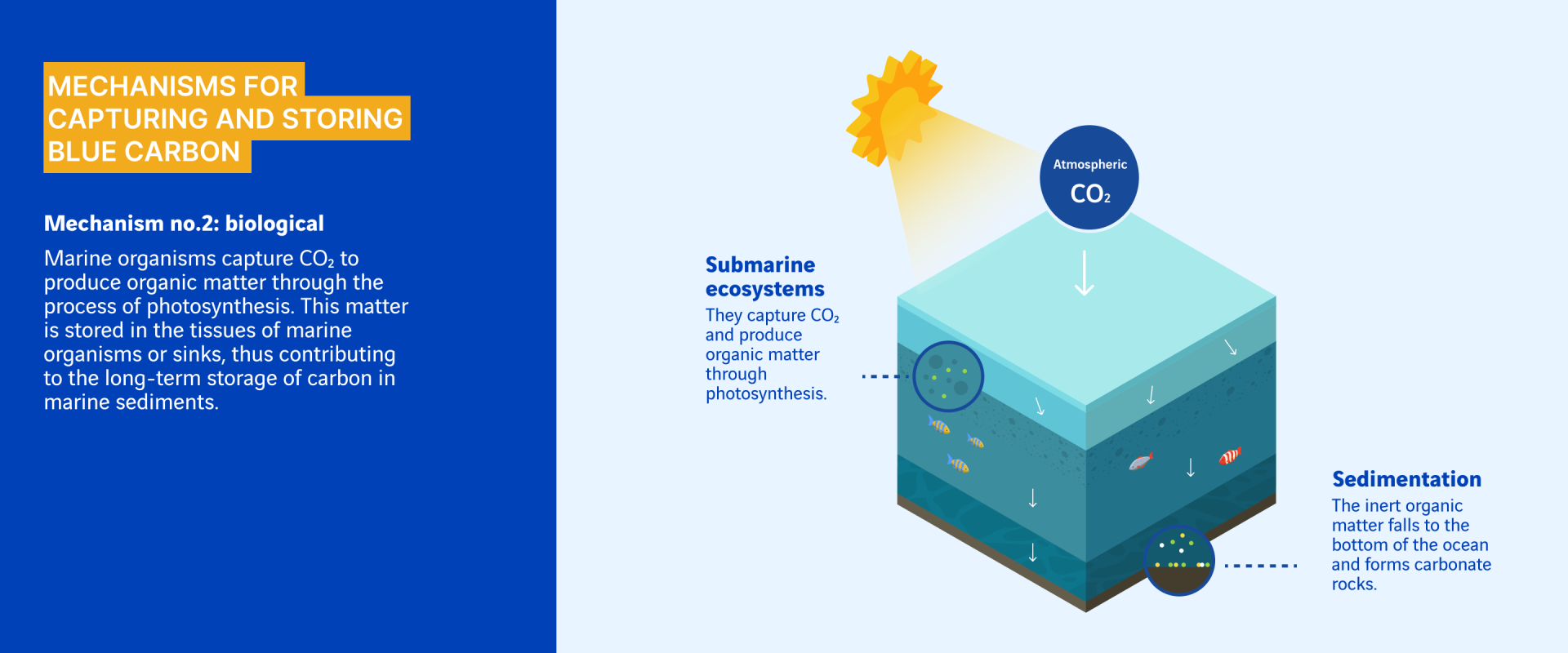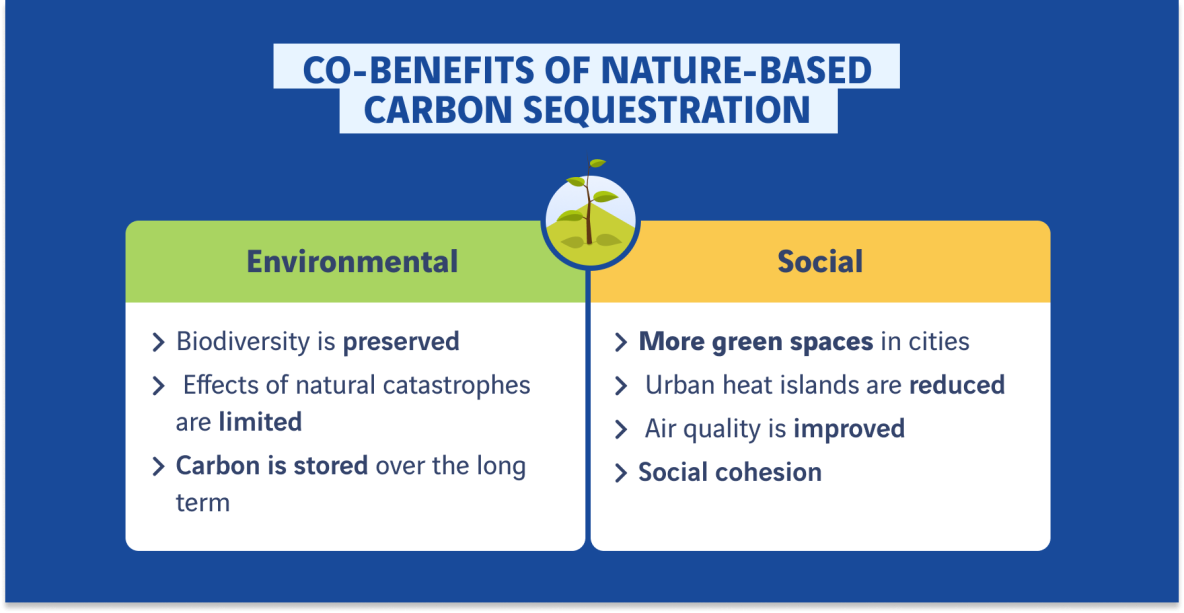
Carbon sequestration: we take a closer look at nature-based solutions
In the fight against global warming, carbon sequestration is a solution to be harnessed. This process helps to reduce the build-up of greenhouse gases in the atmosphere. Of all the carbon sequestration methods, nature-based solutions (NBS) offer the most co-benefits.
Carbon sequestration: what is it?
To achieve carbon neutrality and slow down climate change, reducing the carbon emissions of economic players must remain a priority. However, carbon sequestration also has a role to play. According to the IPPC , carbon sequestration is essential for meeting global climate targets.
But what is it? Carbon sequestration involves capturing and storing CO2, the main gas responsible for global warming. To achieve the net-zero carbon emission by 2050, 100 billion tonnes of CO2 would need to be sequestered every year... compared with 40 million tonnes at present. Efforts thus need to be ramped up.
Two solutions currently exist: those known as nature-based solutions (NBS), and carbon capture and storage (CCS), which uses technology to capture and store carbon. Among these strategies, nature-based solutions are the most virtuous, since their benefits go beyond the purely environmental aspect.
Nature Based Solutions (NBS)
The emission of carbon and its accumulation and storage in different receptacles (oceans, biomass reservoirs, soil, and the atmosphere) is a natural phenomenon on Earth. The accumulation of carbon in the atmosphere is what causes global warming. Increasing the storage capacity of other ecosystems has thus become a key tool for fighting climate change.
The main form of natural carbon sequestration is photosynthesis. Land and marine ecosystems use solar energy to fix CO2 in the form of organic matter (wood, biomass, etc.): the carbon is stored. When it decomposes, this same organic matter helps to form sedimentary rocks in the subsoil and seabed, in which the carbon is then trapped for geological time periods.
Reforestation: a leading solution
Forests are precious carbon sinks, and the second-largest after oceans. Through the natural process of photosynthesis, trees capture CO2 in the atmosphere and store it both in the wood and the soil. They also absorb CO2 produced by any decomposing organic matter in the soil, making them a real long-term carbon storage solution. Along with meadows and wet zones, it is forests that store the most carbon in their subsoils (almost twice as much as orchards and croplands), as they are not ploughed.
of land in France is covered by forests.
of France’s annual CO2 emissions is captured every day by forests
As such, afforestation or reforestation has become one of the main carbon sequestration solutions. The Office National des Forêts, or ONF (France’s national forestry office), manages public forests and supports town planners in the sustainable management of forest ecosystems, both in France and abroad. It is a pioneer in supporting forest carbon sink projects in Latin America, notably Brazil and Colombia, two countries with a vast area covered by the world's largest rainforest: the Amazon.

With the support of the ONF, VINCI Airports is also implementing its local reforestation programme around the Toulon-Hyères and Lyon airports in order to achieve net-zero for scopes 1 and 2, a goal already achieved for the first airport and planned for 2026 the Lyon airports.
Using varieties specially selected for their ability to adapt to climate change, the programme will enable the restoration of two forest plots of almost 4 hectares each near Lyon (Rhône) and 2 hectares near Bormes-les-Mimosas (Var), which was affected by a fire in 2017. In all, more than 1,500 tonnes of CO2 will be sequestered by photosynthesis during the trees' growth phase alone.
In addition to these two projects, and once again based on the Low Carbon Label, VINCI Airports has decided to finance and secure more than 220 hectares of reforestation projects, notably in the Loire region, Brittany and Auvergne Rhône Alpes.
Blue carbon: CO2 captured by ocean floors
Marine ecosystems contribute to the capture and storage of CO2 and already capture more than 50% of the CO2 emitted worldwide: the blue carbon., making our oceans the largest carbon sink on the planet. To do this, the ocean uses, two processes. The first is a physical one whereby: atmospheric CO2 dissolves naturally in water, particularly at low temperatures. Once dissolved, it is naturally stored in the cold water, which, owing to its density, sinks to the seabed. The second process is a biological one and similar to that used by plants: through the process of photosynthesis, underwater flora absorbs and stores CO2. In the Osaka region of Japan, VINCI Airports has tested a blue carbon sink solution near Kansai international airport. Thanks to the campaign implemented to promote the growth of seaweed, around 100 tonnes of CO2 has been captured in just five years.
Ecological restoration: restoring ecosystems to sequester CO2
A third solution is that of ecological restoration, also known as "renaturation". This technique involves restoring nature to its rightful place and (re)greening the landscape, towns in particular. The process aims to offset the harmful effects of soil artificialisation, which causes degradation to ecosystems and biodiversity, while at the same time boosting the potential of land to capture CO2.
Soil artificialisation, or soil sealing, is the development of land using synthetic materials such as bitumen, concrete and cement. This alters the ecological functions of soil and contributes to global warming by rendering surfaces impermeable.
As a result, rain can no longer infiltrate deep into the soil to irrigate trees and vegetation, soil can no longer fulfil its role as a carbon sink, and heat islands form.
To learn more, read the article "Zero net artificialisation".
Avoiding soil artificialisation and (re)greening urban landscapes to enable soil to fulfil its primary carbon capturing function is therefore a priority. This priority has been included in the environmental policies of VINCI subsidiaries. A concrete example is VINCI Immobilier’s objective to achieve "zero net artificialisation" for its activity by 2030. One of the main drivers in its action plan is to ‘renature’ an equivalent surface for each artificialised square metre.

The Revilo® offer developed by VINCI Construction helps to restore green spaces and reverse ground impermeability in cities through four approaches: increasing vegetation; managing rainwater; restoring living soil; and choosing appropriate ground coverings (light-coloured, permeable, etc.).
Nature based carbon sequestration solutions: what are the advantages?
Environmental co-benefits of NBS
Conserving ecosystems and reinforcing their primary functions, such as carbon storage, goes far beyond the mere necessity to reduce the accumulation of greenhouse gases in the atmosphere.
It is also a matter of preserving the biodiversity of these natural areas. The blue carbon sink experiment at Kansai (VINCI Airports) is a good example of this. The seaweed planted not only helped to absorb CO2 and purify the water, but also accelerated the return of fish and crustaceans to the area.
Nature-based carbon capturing solutions also make it possible to combat the consequences of extreme natural phenomena exacerbated by climate change, such as flooding, by restoring the primary functions of soils and their ability to retain water. Lastly, NBS offer long-term CO2 storage: certain ecosystems have the capacity to store carbon for hundreds of years, provided they are managed sustainably.
Social co-benefits of NBS
These solutions go beyond the purely environmental issue and bring numerous social and societal benefits. Increasing vegetation in cities, for example, reduces the sensation of heat islands and improves air quality, offering a real health benefit for city dwellers. The creation of green spaces also encourages the use of public areas, which can become a real driver of social cohesion. This is all the more true given that these carbon capture solutions are welcomed by the public owing to their non-intrusive nature.
Combined with actions to massively reduce CO2 emissions, nature-based solutions are a sustainable means of combating climate change.
Most viewed
Vous aimerez aussi
Words from researchers: let's fight stereotypes!
Charlotte, a research fellow at École des Mines, and Erwan, a university professor and researcher at AgroParisTech, talk…
Fondation VINCI pour la Cité: opening the door to others is another way of reaching out!
With some 1.3 million organisations and 2 million employees, France can lay claim to a dynamic network of associations…
Sea water desalination: a solution for turning the tide on the water scarcity crisis?
As water shortages continue causing havoc in a growing number of regions around the world, an age-old idea is experiencing a…






